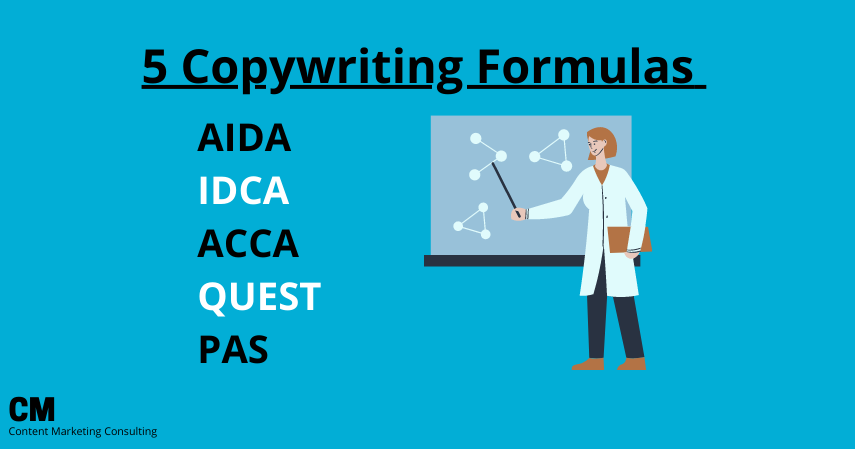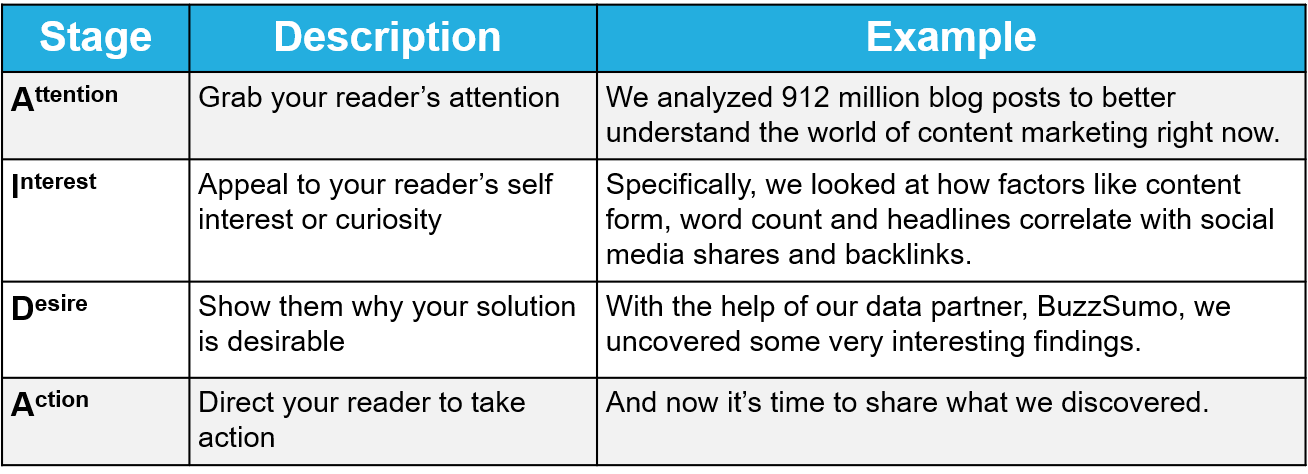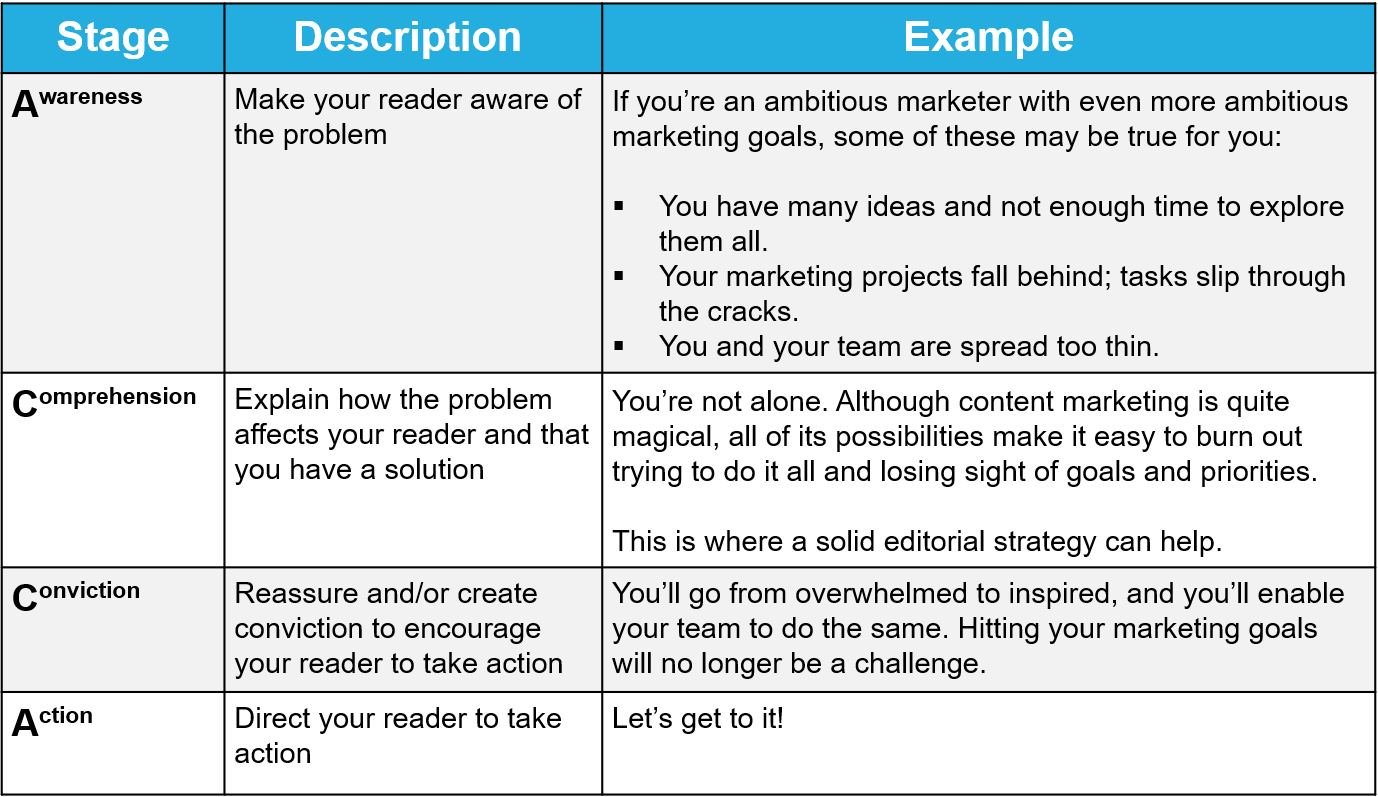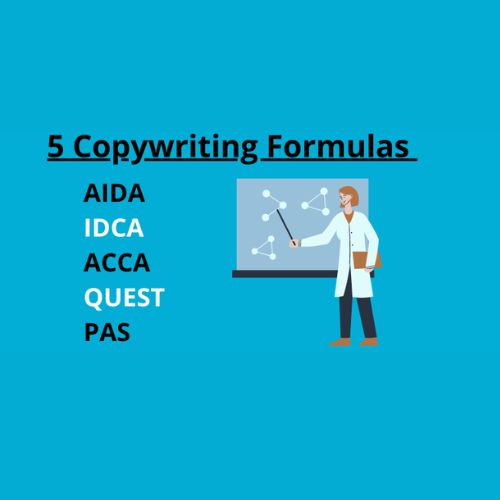
If you want your prospects to turn into customers, first you need them to listen to you.
But just one droning sentence in your blog post introduction. And you lose that chance.
With so little margin for error, you need repeatable, structured processes proven to turn traffic into engagement.
So in this post, through a series of annotated examples and guidance from expert writers, I’ll show you how and when to adapt five well-known copywriting formulas to your blog post introductions.
Each section contains 1) a flashcard defining the formula 2) an annotated example of an introduction using the formula and 3) best practices on how and when to use the formula.
1. Attention, Interest, Desire, Action (AIDA)
What is AIDA?

Example of AIDA in Action
Attention: We analyzed 912 million blog posts to better understand the world of content marketing right now.
Interest: Specifically, we looked at how factors like content format, word count and headlines correlate with social media shares and backlinks.
With the help of our data partner BuzzSumo, we uncovered Desire: some very interesting findings.
Action: And now it’s time to share what we discovered.
How Dean Uses AIDA
Brian Dean snaps your attention onto a gargantuan number in his headline, and reemphasizes it in his first line.
Dean then piques your interest with a tease of the details of his findings before invoking your desire for “very interesting findings.”
His action statement “It’s time to share what we discovered,” propels you down the page.
When to use AIDA
Whether you’re writing a listicle, an expert round up, a case study, or anything in between, AIDA can work.
But just because you can use it anytime doesn’t mean you should. There are two scenarios where you’re better off using a different formula for your blog post introduction, those scenarios are:
- You need to establish context for your reader.
- Your headline has already captured attention.
QUEST works better in scenario #1 and IDCA works better in scenario #2. But more on that in the next two sections.
Qualify, Understand, Educate, Stimulate, Transition (QUEST)

Example of QUEST in Action
Qualify: BLUF is a military communications acronym — it stands for “bottom line up front” — that’s designed to enforce speed and clarity in reports and emails.
The basic idea is simple: put the most important details first. Don’t tease or delay your main point because people are busy and their time is valuable. And make it clear — life-or-death decisions could be made using your information.
Understand: While the decisions you make may not be life-or-death, you probably also spend a lot of your time communicating with people who are busy, whose time is valuable, and who deserve at least the same level of consideration. That’s why BLUF is such a useful model. Whether you’re writing for your company’s blog, writing Slack messages to coworkers, or writing emails to customers, BLUF can help you cut through the noise and connect.
Educate: But BLUF is more than a simple communications tactic. It’s not, as the name might imply, simply about finding your “bottom line” and sticking it at the top of whatever you’re writing.
Stimulate: BLUF, if you apply it consistently throughout your writing, is a way of organizing your thoughts and understanding the narrative that lets you yield your central points to your reader as quickly as possible. Transition: It is a “full body” writing exercise, not a quick and dirty copy and paste.
How Asplund Uses QUEST
To qualify your reader means to reinforce, in your reader’s mind, that what you’re about to tell them will be worthwhile. Since Apslund is introducing a new concept (BLUF) — he needs to prepare his reader for what his post is about.
So he spends his first three sentences explaining what BLUF is, focusing on its benefits: speed, clarity, and simplicity. And, if you want to be a faster, clearer communicator, you keep reading.
Then Apslund turns the spotlight on his audience, showing he understands their scenario, and teasing how BLUF can apply to their blog, Slack messages, and emails.
Next, the author begins his transition, educating you about the true nature of the concept he’s discussing and then stimulating you with a compelling solution:
“A way of organizing your thoughts and understanding the narrative that lets you yield your central points to your reader as quickly as possible.”
The final piece, the transition, doesn’t really exist in this example. But as the inventor of QUEST explains, “QUEST is a guide, not a goal or a rule.”
When to use QUEST
“What” posts, in which you’re explaining a new concept, lend themselves to QUEST because they require preparing the reader.
That said, you can use QUEST on pretty much any content’s introduction except feature stories. Danny Iny uses it in his listicle titled, “21 Ways to Create Compelling Content When You Don’t Have a Clue.”
3. Interest, Desire, Conviction, Action (IDCA)
What is IDCA?

Example of IDCA in Action
Interest: Ever wonder what happens to the 95% of people who visit your website without buying anything?
Many of these visitors leave without ever coming back.
Desire: What if, instead of losing a potential customer, you could add them to your email list and build a relationship with them? What if this was something that would lead to them becoming paying customers?
You can, and you should.
Conviction: As you already know, you can’t make people hand over their email addresses because you made a polite request. You’ll need to offer something of value: a lead magnet.
Action: In this article, you’ll learn what lead magnets are and why you need them to grow your email list. You’ll also find 50 lead magnet ideas for your audience — no matter where they are in your sales funnel.
Ready? Let’s begin.
How Ojaokomo Uses IDCA
In this example, Nathan Ojaokomo piques your interest with an alarming statistic, “95% of people who visit your website without buying anything.”
Then he speaks to your desire: building relationships with potential customers.
And just before calling you to action, Ojaokomo reassures and helps convince you to keep reading by reminding you of a well-established fact: you need to offer something of value to generate leads.
When to use IDCA
IDCA assumes your headline has sufficiently grabbed attention and it adds conviction between desire and action to encourage you to emphasize the desirability of your solution before asking for the sale (or in this case, the read).
This makes them a good fit for “why-posts,” which are posts that provide readers with a reason or purpose and provide details that support a focused conclusion.
For example, “Why most blogs fail (and how to make sure yours doesn’t).”
4. Awareness, Comprehension, Conviction, Action (ACCA)

Example of ACCA in Action
Awareness: If you’re an ambitious marketer with even more ambitious marketing goals, some of these may be true for you:
You have many ideas and not enough time to explore them all.
Your marketing projects fall behind; tasks slip through the cracks.
You have to press pause on promising projects because business priorities have changed.
You and your team are spread too thin.
How many of these are your pitfalls? One? Two? All of them?
Comprehension: You’re not alone. Although content marketing is quite magical, all of its possibilities make it easy to burn out trying to do it all and losing sight of goals and priorities.
This is where a solid editorial strategy can help. In this guide, you’ll easily develop one. You’ll learn:
How to focus on your most valuable audience, so you can help them hit their goals while you hit your own.
The tools and practices that will help you streamline content creation without sacrificing its quality or consistency.
An efficient strategy to turn a big-picture marketing overview into actionable tasks, so that no project ever falls behind.
Conviction: You’ll go from overwhelmed to inspired, and you’ll enable your team to do the same. Hitting your marketing goals will no longer be a challenge.
How Kay Uses ACCA
Kay starts by describing a related group of pain points. And though she doesn’t explicitly say it, the reader can assume these problems have something to do with their editorial strategy.
Then she adds clarity, explaining how the problem affects the reader and showing that she has the solution: an editorial strategy.
Finally, to encourage readers to take action, she creates conviction, telling readers they’ll “go from overwhelmed to inspired.”
And in a good example of why formulas in copywriting aren’t rigid like they are in mathematics, Kay skips using her introduction to direct the reader to keep reading. Probably because, after her introduction, but before the body of the post, CoSchedule has a visual CTA for an editorial strategy template.
When to Use ACCA
As Stacey Corrin explains, ACCA is a variation of AIDA with a focus on clarity and greater understanding.
Hence, when you want to take a more empathic, educational approach that builds momentum as it goes, ACCA is the way to go.
It’s also a useful approach for subject matter that’s more conceptual in nature, such as a how-to post about a nuanced subject like strategy.
5. Problem, Agitate, Solution (PAS)
What is PAS?

Example of PAS in Action
Problem: Writing titles for blog posts is hard because it requires a different type of thinking than you use for general writing.
When you finish writing an article, you understand the topic you’ve just written about at a deeper level than ever before. You’ve just spent hours/days/weeks organizing your thoughts into words. You can speak eloquently on the topic.
Agitate: To come up with a good title for that piece, however, you need to find a framing of the topic that will make sense and interest someone who knows none of what you now know. You have to think like a complete beginner — go back in time to before you understood everything you understand now.
Solution: One of the best ways to go back in time is to use a collection of mental models to put yourself in a different frame of mind. With the right mental toolset, you can help your brain snap out of “expert mode” and into that fruitful beginner mode much faster.
How Asplund Uses PAS
Asplund shows you how to use the simple PAS formula without being lazy or reptitive. He doesn’t just say: “We all know how hard it is to write blog post titles.”
He explains why it’s hard, forcing you to look at an old problem through a new frame. Then he agitates you, expressing the difficulty of solving this problem. He’s setting up his solution, increasing the chances that you’ll be receptive when he presents it.
And then he presents, and sells, the solution: “a collection of mental models” that will “help your brain snap out of ‘expert mode’ and into that fruitful beginner mode much faster.”
When to Use PAS
PAS works in many scenarios, but especially when you’re presenting a solution to a known problem.
For example, this post (the one you’re reading) is about blog post introductions, Asplund’s is about blog post titles, and Nadya Khoja’s is about using SEO data to inform your post-Covid marketing strategy.
Each of them use the PAS construction for their intros.
Epilogue: Do Copywriting Formulas Work?
Copywriting formulas won’t stop your writing from sucking.
Even if you nail every step of the formula, that doesn’t mean your writing can’t still be stale. And that’s okay, because this kind of formula isn’t meant as a cure-all.
Instead, formulas give you a structure. And that structure provides a starting point that makes it easier to write consistently good blog post introductions.

